Personal Finance Assignment - Course Name, Semester Details
VerifiedAdded on 2020/03/01
|8
|1674
|104
Homework Assignment
AI Summary
This assignment delves into various aspects of personal finance, beginning with strategies to improve financial literacy in Canada, advocating for mobile applications, and a structured framework. It then addresses debt management, offering advice on stopping borrowing, creating emergency funds, budgeting, organizing debt, and paying it off. The assignment also includes a section on purchasing property, outlining financial goals, expected costs, savings plans, and adaptation strategies for potential challenges. Furthermore, it presents a retirement plan argument, emphasizing the benefits of early investment. Finally, it identifies the most valuable lesson learned in a personal finance class: the importance of managing finances effectively and distinguishing between assets and liabilities, which is crucial for financial independence and an improved quality of life. The assignment includes references to financial planning resources.

1
Name:
Course
Professor’s name
University name
City, State
Date of submission
Name:
Course
Professor’s name
University name
City, State
Date of submission
Paraphrase This Document
Need a fresh take? Get an instant paraphrase of this document with our AI Paraphraser
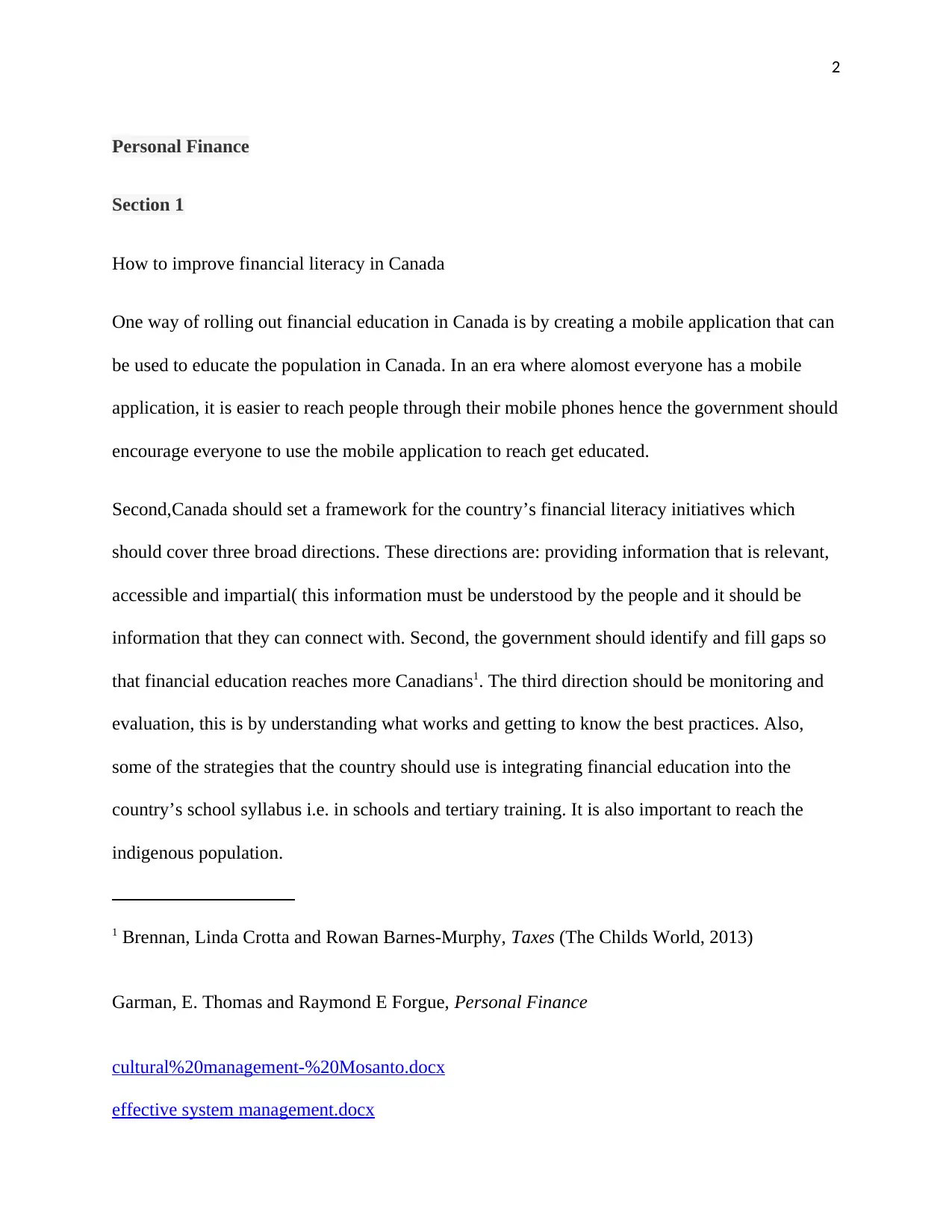
2
Personal Finance
Section 1
How to improve financial literacy in Canada
One way of rolling out financial education in Canada is by creating a mobile application that can
be used to educate the population in Canada. In an era where alomost everyone has a mobile
application, it is easier to reach people through their mobile phones hence the government should
encourage everyone to use the mobile application to reach get educated.
Second,Canada should set a framework for the country’s financial literacy initiatives which
should cover three broad directions. These directions are: providing information that is relevant,
accessible and impartial( this information must be understood by the people and it should be
information that they can connect with. Second, the government should identify and fill gaps so
that financial education reaches more Canadians1. The third direction should be monitoring and
evaluation, this is by understanding what works and getting to know the best practices. Also,
some of the strategies that the country should use is integrating financial education into the
country’s school syllabus i.e. in schools and tertiary training. It is also important to reach the
indigenous population.
1 Brennan, Linda Crotta and Rowan Barnes-Murphy, Taxes (The Childs World, 2013)
Garman, E. Thomas and Raymond E Forgue, Personal Finance
cultural%20management-%20Mosanto.docx
effective system management.docx
Personal Finance
Section 1
How to improve financial literacy in Canada
One way of rolling out financial education in Canada is by creating a mobile application that can
be used to educate the population in Canada. In an era where alomost everyone has a mobile
application, it is easier to reach people through their mobile phones hence the government should
encourage everyone to use the mobile application to reach get educated.
Second,Canada should set a framework for the country’s financial literacy initiatives which
should cover three broad directions. These directions are: providing information that is relevant,
accessible and impartial( this information must be understood by the people and it should be
information that they can connect with. Second, the government should identify and fill gaps so
that financial education reaches more Canadians1. The third direction should be monitoring and
evaluation, this is by understanding what works and getting to know the best practices. Also,
some of the strategies that the country should use is integrating financial education into the
country’s school syllabus i.e. in schools and tertiary training. It is also important to reach the
indigenous population.
1 Brennan, Linda Crotta and Rowan Barnes-Murphy, Taxes (The Childs World, 2013)
Garman, E. Thomas and Raymond E Forgue, Personal Finance
cultural%20management-%20Mosanto.docx
effective system management.docx
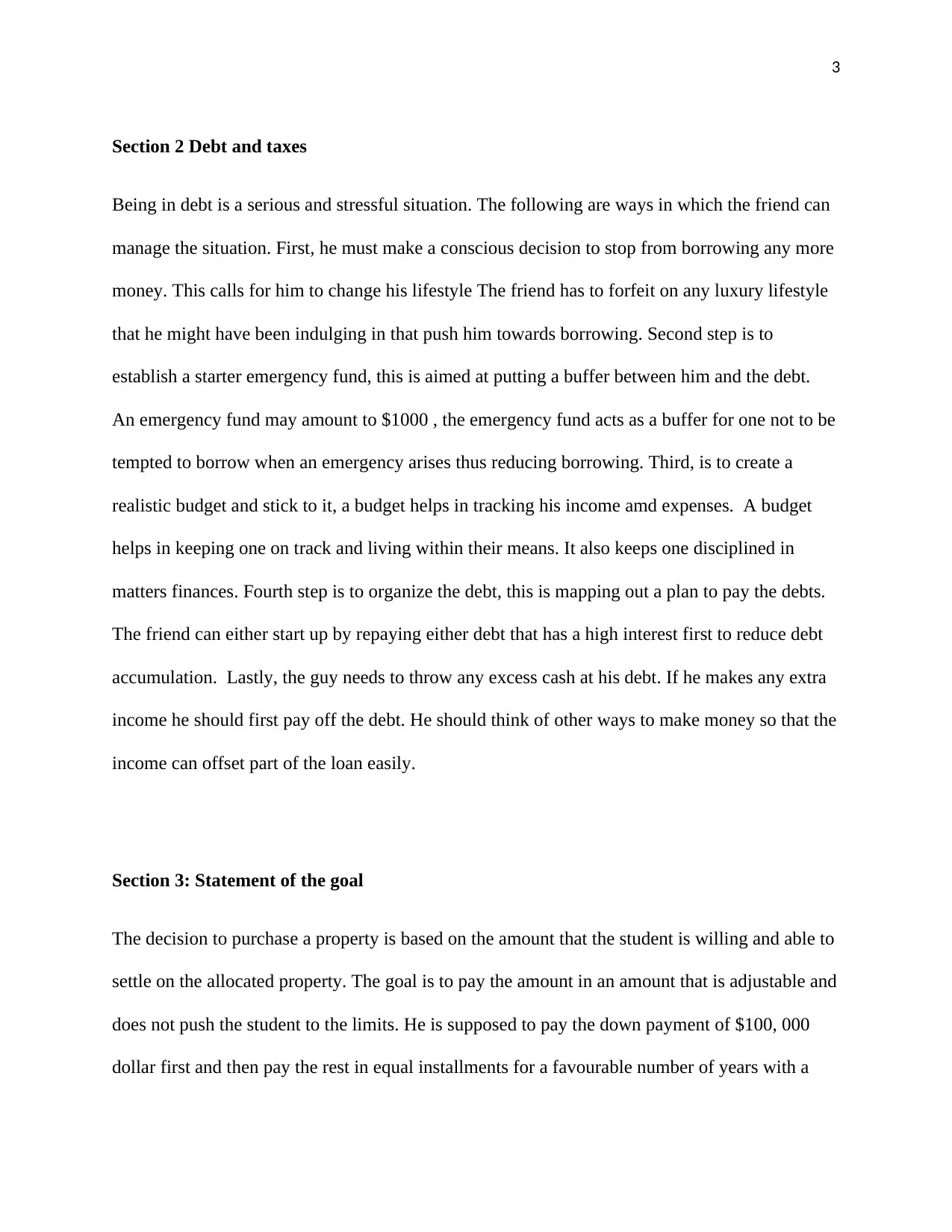
3
Section 2 Debt and taxes
Being in debt is a serious and stressful situation. The following are ways in which the friend can
manage the situation. First, he must make a conscious decision to stop from borrowing any more
money. This calls for him to change his lifestyle The friend has to forfeit on any luxury lifestyle
that he might have been indulging in that push him towards borrowing. Second step is to
establish a starter emergency fund, this is aimed at putting a buffer between him and the debt.
An emergency fund may amount to $1000 , the emergency fund acts as a buffer for one not to be
tempted to borrow when an emergency arises thus reducing borrowing. Third, is to create a
realistic budget and stick to it, a budget helps in tracking his income amd expenses. A budget
helps in keeping one on track and living within their means. It also keeps one disciplined in
matters finances. Fourth step is to organize the debt, this is mapping out a plan to pay the debts.
The friend can either start up by repaying either debt that has a high interest first to reduce debt
accumulation. Lastly, the guy needs to throw any excess cash at his debt. If he makes any extra
income he should first pay off the debt. He should think of other ways to make money so that the
income can offset part of the loan easily.
Section 3: Statement of the goal
The decision to purchase a property is based on the amount that the student is willing and able to
settle on the allocated property. The goal is to pay the amount in an amount that is adjustable and
does not push the student to the limits. He is supposed to pay the down payment of $100, 000
dollar first and then pay the rest in equal installments for a favourable number of years with a
Section 2 Debt and taxes
Being in debt is a serious and stressful situation. The following are ways in which the friend can
manage the situation. First, he must make a conscious decision to stop from borrowing any more
money. This calls for him to change his lifestyle The friend has to forfeit on any luxury lifestyle
that he might have been indulging in that push him towards borrowing. Second step is to
establish a starter emergency fund, this is aimed at putting a buffer between him and the debt.
An emergency fund may amount to $1000 , the emergency fund acts as a buffer for one not to be
tempted to borrow when an emergency arises thus reducing borrowing. Third, is to create a
realistic budget and stick to it, a budget helps in tracking his income amd expenses. A budget
helps in keeping one on track and living within their means. It also keeps one disciplined in
matters finances. Fourth step is to organize the debt, this is mapping out a plan to pay the debts.
The friend can either start up by repaying either debt that has a high interest first to reduce debt
accumulation. Lastly, the guy needs to throw any excess cash at his debt. If he makes any extra
income he should first pay off the debt. He should think of other ways to make money so that the
income can offset part of the loan easily.
Section 3: Statement of the goal
The decision to purchase a property is based on the amount that the student is willing and able to
settle on the allocated property. The goal is to pay the amount in an amount that is adjustable and
does not push the student to the limits. He is supposed to pay the down payment of $100, 000
dollar first and then pay the rest in equal installments for a favourable number of years with a
⊘ This is a preview!⊘
Do you want full access?
Subscribe today to unlock all pages.

Trusted by 1+ million students worldwide
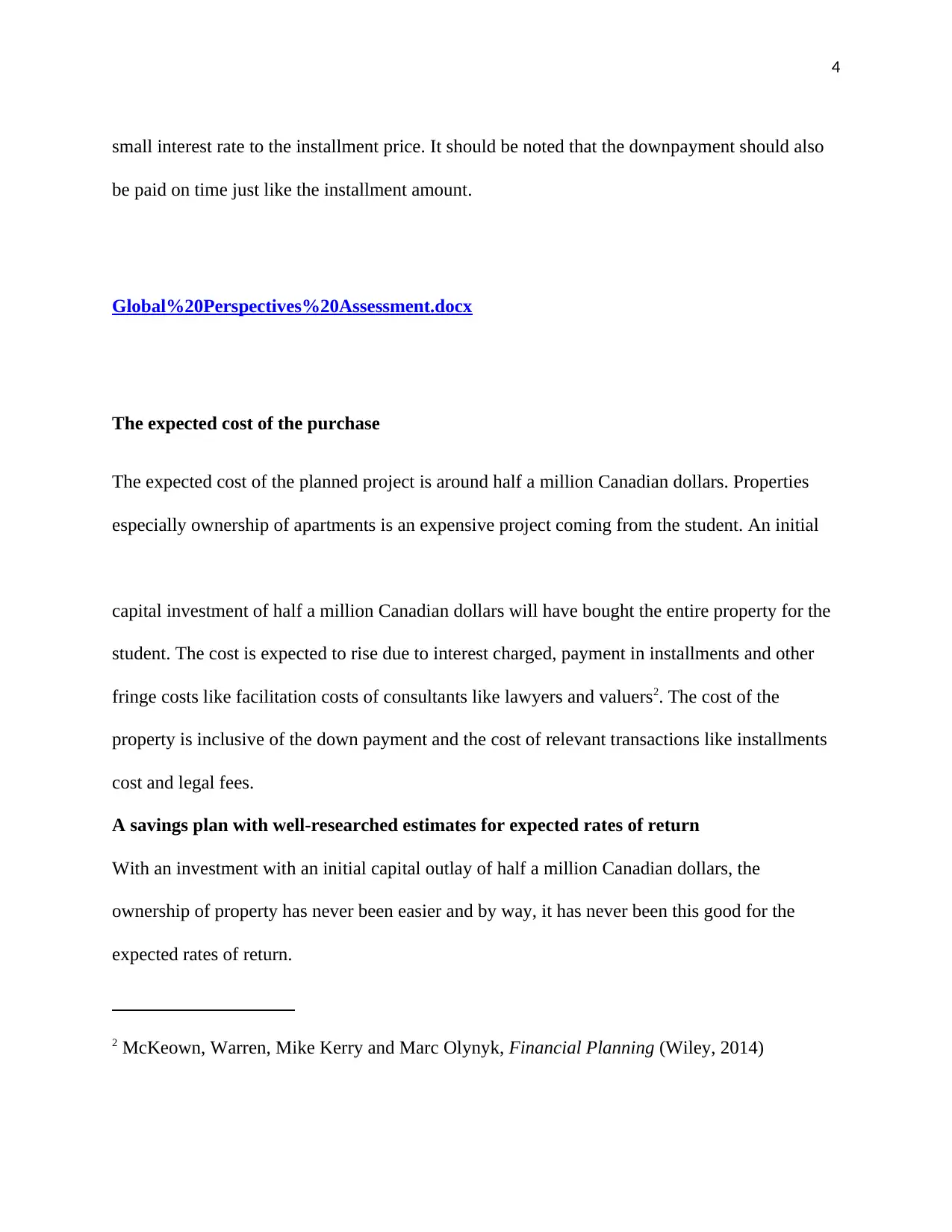
4
small interest rate to the installment price. It should be noted that the downpayment should also
be paid on time just like the installment amount.
Global%20Perspectives%20Assessment.docx
The expected cost of the purchase
The expected cost of the planned project is around half a million Canadian dollars. Properties
especially ownership of apartments is an expensive project coming from the student. An initial
capital investment of half a million Canadian dollars will have bought the entire property for the
student. The cost is expected to rise due to interest charged, payment in installments and other
fringe costs like facilitation costs of consultants like lawyers and valuers2. The cost of the
property is inclusive of the down payment and the cost of relevant transactions like installments
cost and legal fees.
A savings plan with well-researched estimates for expected rates of return
With an investment with an initial capital outlay of half a million Canadian dollars, the
ownership of property has never been easier and by way, it has never been this good for the
expected rates of return.
2 McKeown, Warren, Mike Kerry and Marc Olynyk, Financial Planning (Wiley, 2014)
small interest rate to the installment price. It should be noted that the downpayment should also
be paid on time just like the installment amount.
Global%20Perspectives%20Assessment.docx
The expected cost of the purchase
The expected cost of the planned project is around half a million Canadian dollars. Properties
especially ownership of apartments is an expensive project coming from the student. An initial
capital investment of half a million Canadian dollars will have bought the entire property for the
student. The cost is expected to rise due to interest charged, payment in installments and other
fringe costs like facilitation costs of consultants like lawyers and valuers2. The cost of the
property is inclusive of the down payment and the cost of relevant transactions like installments
cost and legal fees.
A savings plan with well-researched estimates for expected rates of return
With an investment with an initial capital outlay of half a million Canadian dollars, the
ownership of property has never been easier and by way, it has never been this good for the
expected rates of return.
2 McKeown, Warren, Mike Kerry and Marc Olynyk, Financial Planning (Wiley, 2014)
Paraphrase This Document
Need a fresh take? Get an instant paraphrase of this document with our AI Paraphraser
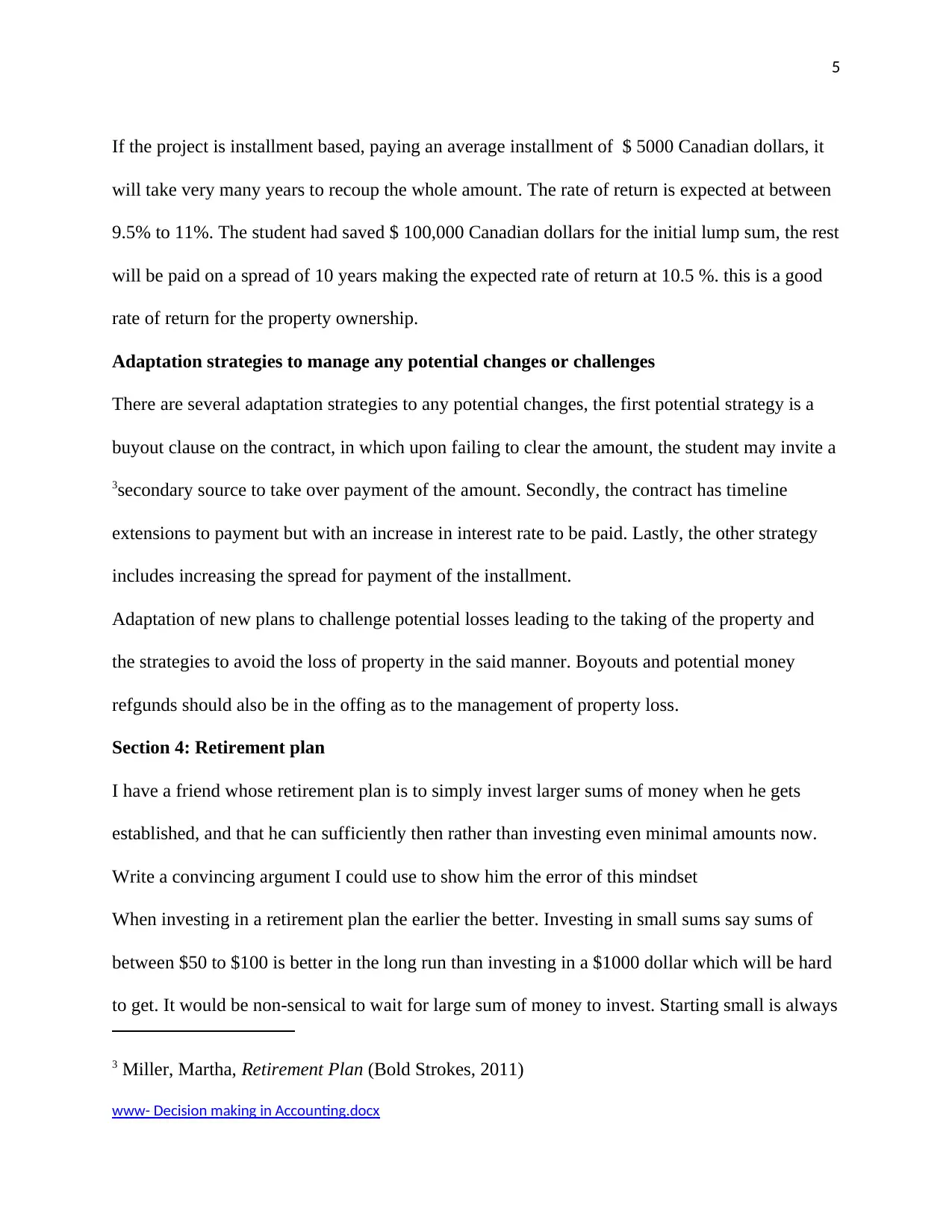
5
If the project is installment based, paying an average installment of $ 5000 Canadian dollars, it
will take very many years to recoup the whole amount. The rate of return is expected at between
9.5% to 11%. The student had saved $ 100,000 Canadian dollars for the initial lump sum, the rest
will be paid on a spread of 10 years making the expected rate of return at 10.5 %. this is a good
rate of return for the property ownership.
Adaptation strategies to manage any potential changes or challenges
There are several adaptation strategies to any potential changes, the first potential strategy is a
buyout clause on the contract, in which upon failing to clear the amount, the student may invite a
3secondary source to take over payment of the amount. Secondly, the contract has timeline
extensions to payment but with an increase in interest rate to be paid. Lastly, the other strategy
includes increasing the spread for payment of the installment.
Adaptation of new plans to challenge potential losses leading to the taking of the property and
the strategies to avoid the loss of property in the said manner. Boyouts and potential money
refgunds should also be in the offing as to the management of property loss.
Section 4: Retirement plan
I have a friend whose retirement plan is to simply invest larger sums of money when he gets
established, and that he can sufficiently then rather than investing even minimal amounts now.
Write a convincing argument I could use to show him the error of this mindset
When investing in a retirement plan the earlier the better. Investing in small sums say sums of
between $50 to $100 is better in the long run than investing in a $1000 dollar which will be hard
to get. It would be non-sensical to wait for large sum of money to invest. Starting small is always
3 Miller, Martha, Retirement Plan (Bold Strokes, 2011)
www- Decision making in Accounting.docx
If the project is installment based, paying an average installment of $ 5000 Canadian dollars, it
will take very many years to recoup the whole amount. The rate of return is expected at between
9.5% to 11%. The student had saved $ 100,000 Canadian dollars for the initial lump sum, the rest
will be paid on a spread of 10 years making the expected rate of return at 10.5 %. this is a good
rate of return for the property ownership.
Adaptation strategies to manage any potential changes or challenges
There are several adaptation strategies to any potential changes, the first potential strategy is a
buyout clause on the contract, in which upon failing to clear the amount, the student may invite a
3secondary source to take over payment of the amount. Secondly, the contract has timeline
extensions to payment but with an increase in interest rate to be paid. Lastly, the other strategy
includes increasing the spread for payment of the installment.
Adaptation of new plans to challenge potential losses leading to the taking of the property and
the strategies to avoid the loss of property in the said manner. Boyouts and potential money
refgunds should also be in the offing as to the management of property loss.
Section 4: Retirement plan
I have a friend whose retirement plan is to simply invest larger sums of money when he gets
established, and that he can sufficiently then rather than investing even minimal amounts now.
Write a convincing argument I could use to show him the error of this mindset
When investing in a retirement plan the earlier the better. Investing in small sums say sums of
between $50 to $100 is better in the long run than investing in a $1000 dollar which will be hard
to get. It would be non-sensical to wait for large sum of money to invest. Starting small is always
3 Miller, Martha, Retirement Plan (Bold Strokes, 2011)
www- Decision making in Accounting.docx
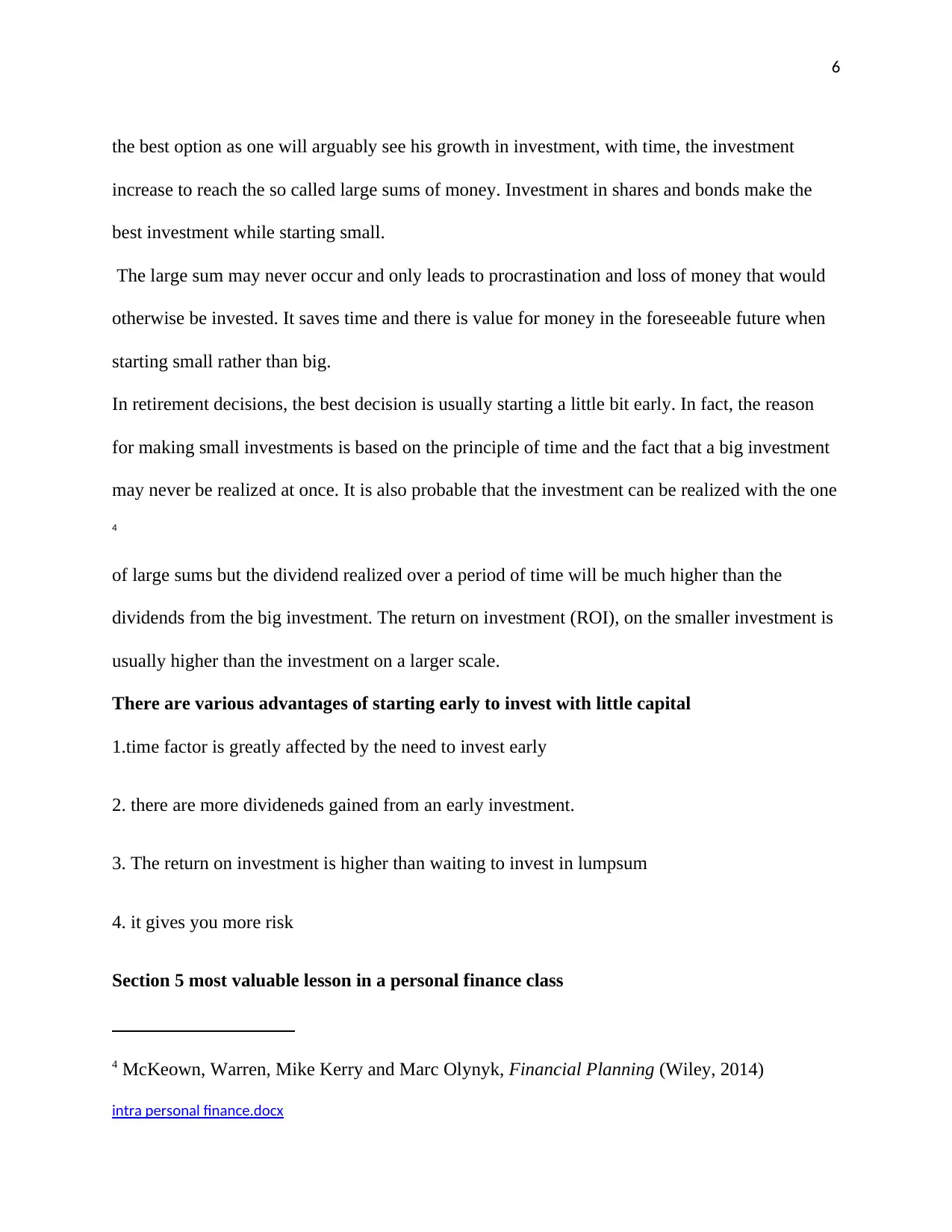
6
the best option as one will arguably see his growth in investment, with time, the investment
increase to reach the so called large sums of money. Investment in shares and bonds make the
best investment while starting small.
The large sum may never occur and only leads to procrastination and loss of money that would
otherwise be invested. It saves time and there is value for money in the foreseeable future when
starting small rather than big.
In retirement decisions, the best decision is usually starting a little bit early. In fact, the reason
for making small investments is based on the principle of time and the fact that a big investment
may never be realized at once. It is also probable that the investment can be realized with the one
4
of large sums but the dividend realized over a period of time will be much higher than the
dividends from the big investment. The return on investment (ROI), on the smaller investment is
usually higher than the investment on a larger scale.
There are various advantages of starting early to invest with little capital
1.time factor is greatly affected by the need to invest early
2. there are more divideneds gained from an early investment.
3. The return on investment is higher than waiting to invest in lumpsum
4. it gives you more risk
Section 5 most valuable lesson in a personal finance class
4 McKeown, Warren, Mike Kerry and Marc Olynyk, Financial Planning (Wiley, 2014)
intra personal finance.docx
the best option as one will arguably see his growth in investment, with time, the investment
increase to reach the so called large sums of money. Investment in shares and bonds make the
best investment while starting small.
The large sum may never occur and only leads to procrastination and loss of money that would
otherwise be invested. It saves time and there is value for money in the foreseeable future when
starting small rather than big.
In retirement decisions, the best decision is usually starting a little bit early. In fact, the reason
for making small investments is based on the principle of time and the fact that a big investment
may never be realized at once. It is also probable that the investment can be realized with the one
4
of large sums but the dividend realized over a period of time will be much higher than the
dividends from the big investment. The return on investment (ROI), on the smaller investment is
usually higher than the investment on a larger scale.
There are various advantages of starting early to invest with little capital
1.time factor is greatly affected by the need to invest early
2. there are more divideneds gained from an early investment.
3. The return on investment is higher than waiting to invest in lumpsum
4. it gives you more risk
Section 5 most valuable lesson in a personal finance class
4 McKeown, Warren, Mike Kerry and Marc Olynyk, Financial Planning (Wiley, 2014)
intra personal finance.docx
⊘ This is a preview!⊘
Do you want full access?
Subscribe today to unlock all pages.

Trusted by 1+ million students worldwide
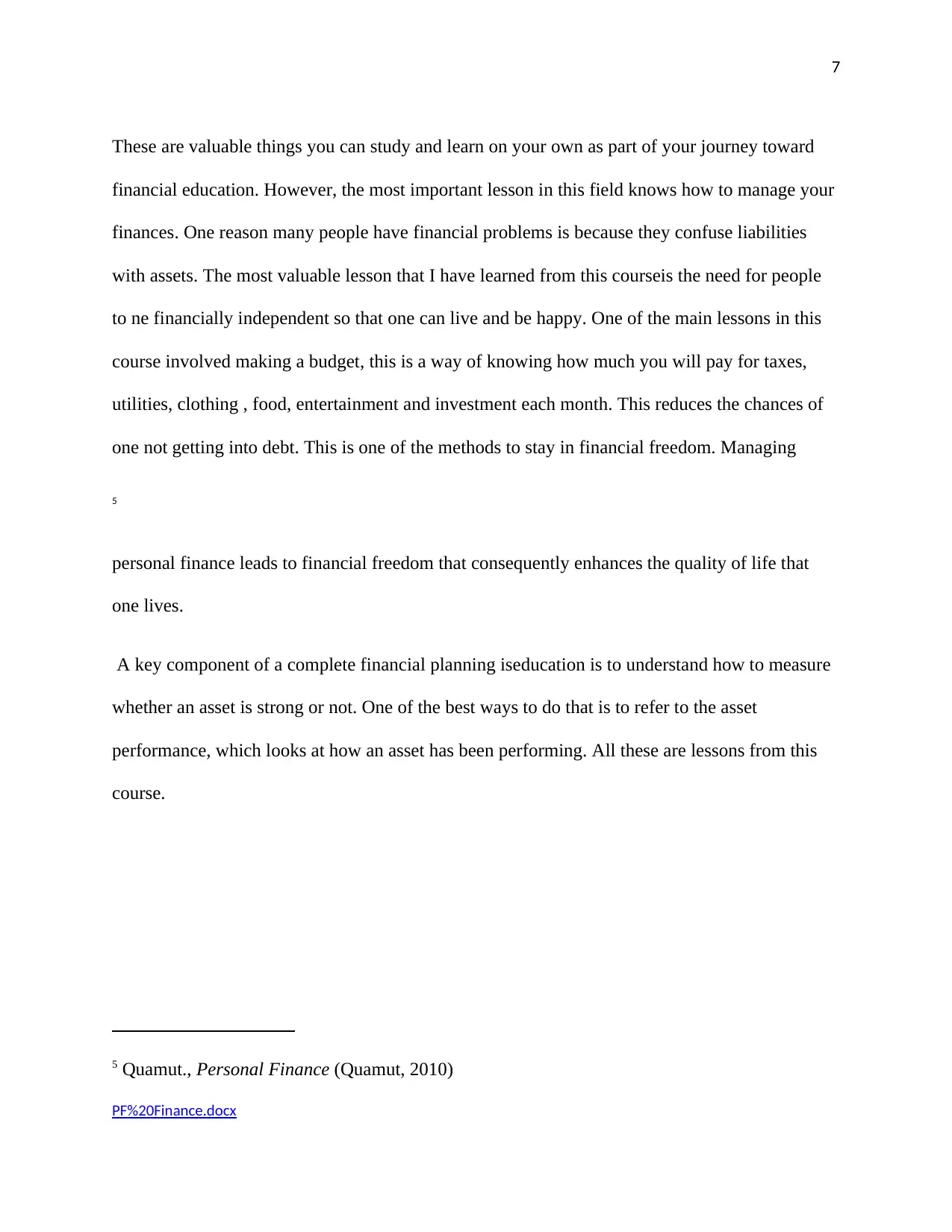
7
These are valuable things you can study and learn on your own as part of your journey toward
financial education. However, the most important lesson in this field knows how to manage your
finances. One reason many people have financial problems is because they confuse liabilities
with assets. The most valuable lesson that I have learned from this courseis the need for people
to ne financially independent so that one can live and be happy. One of the main lessons in this
course involved making a budget, this is a way of knowing how much you will pay for taxes,
utilities, clothing , food, entertainment and investment each month. This reduces the chances of
one not getting into debt. This is one of the methods to stay in financial freedom. Managing
5
personal finance leads to financial freedom that consequently enhances the quality of life that
one lives.
A key component of a complete financial planning iseducation is to understand how to measure
whether an asset is strong or not. One of the best ways to do that is to refer to the asset
performance, which looks at how an asset has been performing. All these are lessons from this
course.
5 Quamut., Personal Finance (Quamut, 2010)
PF%20Finance.docx
These are valuable things you can study and learn on your own as part of your journey toward
financial education. However, the most important lesson in this field knows how to manage your
finances. One reason many people have financial problems is because they confuse liabilities
with assets. The most valuable lesson that I have learned from this courseis the need for people
to ne financially independent so that one can live and be happy. One of the main lessons in this
course involved making a budget, this is a way of knowing how much you will pay for taxes,
utilities, clothing , food, entertainment and investment each month. This reduces the chances of
one not getting into debt. This is one of the methods to stay in financial freedom. Managing
5
personal finance leads to financial freedom that consequently enhances the quality of life that
one lives.
A key component of a complete financial planning iseducation is to understand how to measure
whether an asset is strong or not. One of the best ways to do that is to refer to the asset
performance, which looks at how an asset has been performing. All these are lessons from this
course.
5 Quamut., Personal Finance (Quamut, 2010)
PF%20Finance.docx
Paraphrase This Document
Need a fresh take? Get an instant paraphrase of this document with our AI Paraphraser
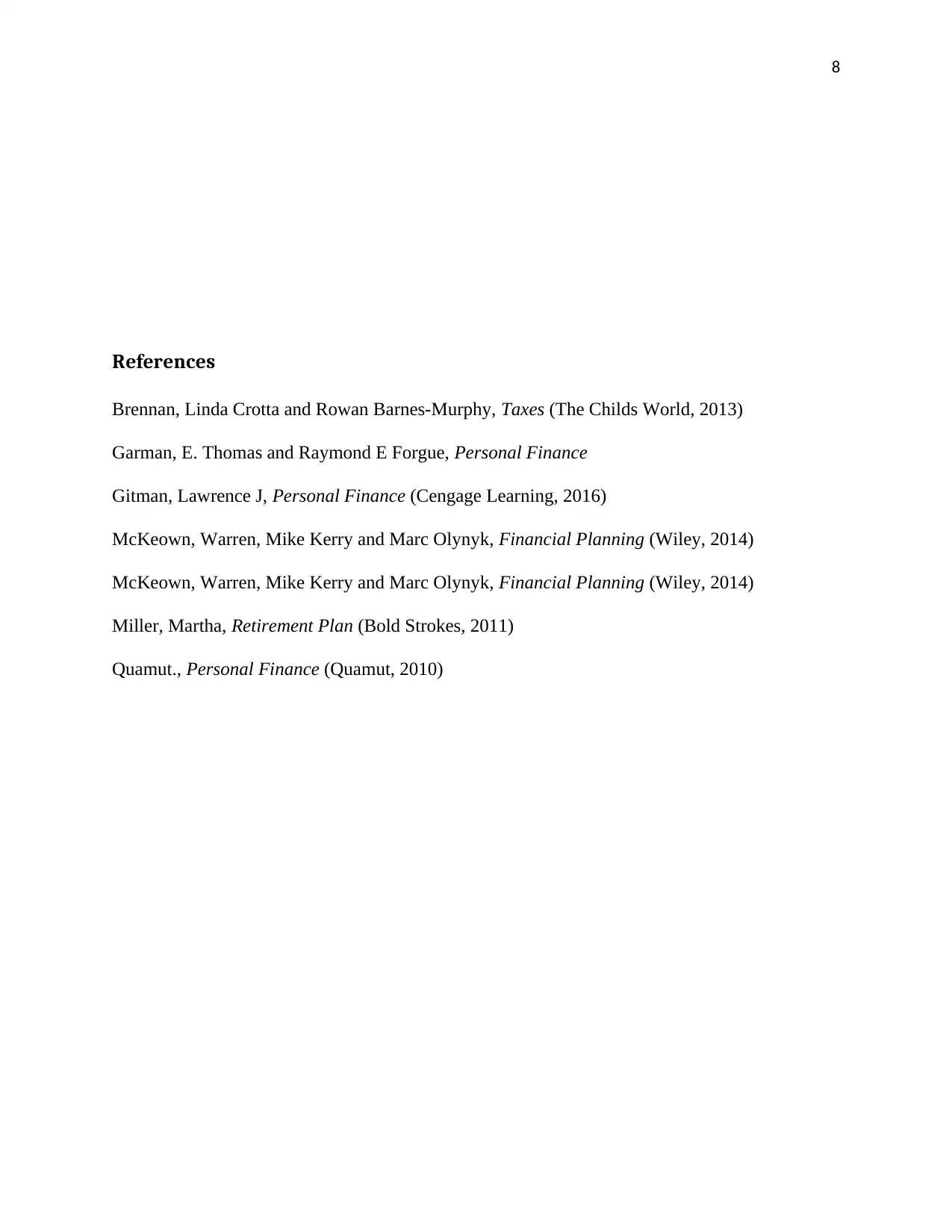
8
References
Brennan, Linda Crotta and Rowan Barnes-Murphy, Taxes (The Childs World, 2013)
Garman, E. Thomas and Raymond E Forgue, Personal Finance
Gitman, Lawrence J, Personal Finance (Cengage Learning, 2016)
McKeown, Warren, Mike Kerry and Marc Olynyk, Financial Planning (Wiley, 2014)
McKeown, Warren, Mike Kerry and Marc Olynyk, Financial Planning (Wiley, 2014)
Miller, Martha, Retirement Plan (Bold Strokes, 2011)
Quamut., Personal Finance (Quamut, 2010)
References
Brennan, Linda Crotta and Rowan Barnes-Murphy, Taxes (The Childs World, 2013)
Garman, E. Thomas and Raymond E Forgue, Personal Finance
Gitman, Lawrence J, Personal Finance (Cengage Learning, 2016)
McKeown, Warren, Mike Kerry and Marc Olynyk, Financial Planning (Wiley, 2014)
McKeown, Warren, Mike Kerry and Marc Olynyk, Financial Planning (Wiley, 2014)
Miller, Martha, Retirement Plan (Bold Strokes, 2011)
Quamut., Personal Finance (Quamut, 2010)
1 out of 8
Your All-in-One AI-Powered Toolkit for Academic Success.
+13062052269
info@desklib.com
Available 24*7 on WhatsApp / Email
![[object Object]](/_next/static/media/star-bottom.7253800d.svg)
Unlock your academic potential
Copyright © 2020–2025 A2Z Services. All Rights Reserved. Developed and managed by ZUCOL.


